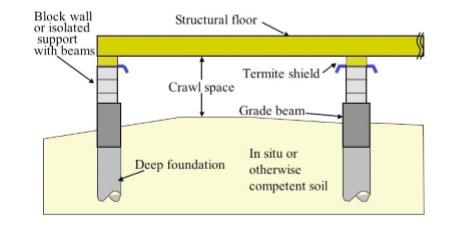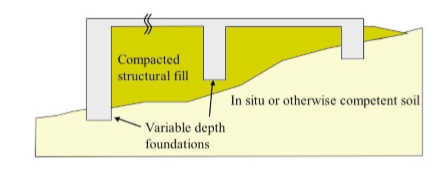| 1. |
Aside from supporting the building loads, the goal of structural foundation design in expansive soil areas should be to economically mitigate the detrimental effects of foundation movement. |
|
|
This can be done by isolating elements of the foundation system from potential soil movements. |
|
|
This can be done by utilizing design methods and details that help to control the effects of the movement of the soil. |
|
|
Both of the above. |
| 2. |
Movements of expansive clay soils are generally restricted to an ______________ of soils known as the active zone. |
|
|
Upper zone |
|
|
Lower zone |
| 3. |
The lower boundary of this zone is commonly defined as |
|
|
zero movement. |
|
|
dead zone. |
| 4. |
In this document, the foundation system is considered to include the structural floor framing system at or near grade level and all other structural components beneath the building. The building superstructure consists of all structural elements above the grade level floor |
|
|
True |
|
|
False |
| 5. |
The foundation systems are subdivided into two groups: deep support systems and shallow support systems. Each of these systems has an associated level of risk of damage that can occur to the building superstructure and architectural components due to differential foundation movements. Each of these systems also has an associated relative cost of construction. When comparing the various foundation systems, the level of risk is typically found to be inversely proportional to the level of cost. Higher risks are often accepted due to economic considerations. For example, shallow support systems typically have a relatively higher level of risk than deep support systems but are often selected due to economics and affordability. |
|
|
True |
|
|
False |
| 6. |
Deep support systems are defined as |
|
|
foundations having deep components such as drilled piers or piles that extend well below the moisture active zone of the soils. |
|
|
deep, thicker foundations. |
| 7. |
Isolated structural systems are characterized as having a superstructure and a grade level structural floor system that are designed to be physically isolated from the effects of vertical movements of expansive soils. This is accomplished by providing sufficient space between the bottom of the floor system components and the top of the soil that will allow the underlying expansive soil to heave into the space or subside without causing movement of the floor system. |
|
|
True |
|
|
False |
| 8. |
Figure 4.1.1.2 shows

|
|
|
Structural floor with room for basement. |
|
|
Structural floor with Crawl space and deep foundation. |
| 9. |
The stiffened structural slab with deep foundations is the same as the structural slab with void space and deep foundations with the following exception: the slab is placed, ____________, over the expansive soils and new fill, and the foundation must be designed to accommodate the pressures from the swelling soils. |
|
|
without a void |
|
|
with a void |
| 10. |
Non-stiffened slab-on-grade with deep foundations consists of a slab-on-grade with grade beams _________________by deep foundations. The foundation will move with the underlying soils. The foundation has little resistance to soil movement with this system. Perimeter grade beams are typically provided with this system to support the exterior wall system and to reduce undermining by erosion. They can also function as a root retarder or vertical moisture retarder. Interior grade beams are also usually provided under all interior load-bearing walls and shear walls. Interior columns are typically supported directly by deep foundations. |
|
|
under load bearing walls supported |
|
|
supported |
| 11. |
Grade supported Stiffened Structural Slab is similar to that discussed in Section 4.1.2, except that the grade beams ______ supported directly by the underlying soils instead of spanning to deep foundations. |
|
|
are not |
|
|
are |
| 12. |
Grade- Supported Stiffened Non- Structural Slab is similar to that discussed in Section 4.1.3, except that the grade beams _______ supported directly by the underlying soils instead of spanning to deep foundations. It is also similar to Section 4.2.1 except that the entire stiffened slab is supported by the surface soils that are susceptible to the seasonal moisture fluctuations and movement. |
|
|
are |
|
|
are not |
| 13. |
Grade supported Non- Stiffened Slab of Uniform Thickness consists of a concrete slab-on-grade of uniform thickness with _______ support foundation components. The slab can be supported on in situ soils or compacted fill. This foundation system should be designed by the PTI method or other acceptable engineering methods to resist the potential bending moments induced by the differential deflections of the slab when subject to expansive soil movements. |
|
|
deep |
|
|
no deep |
| 14. |
Mixed depth systems are foundations that extend to different bearing depths. They are sometimes used to support concentrated loads. Although their use is discouraged for certain applications, mixed depth foundation systems are sometimes used. They can be used for new buildings with large plan areas located on a site with widely varying soil conditions, for new buildings on sites with a substantial amount of deep fill, for new buildings on a sloping hillside, for new buildings located next to a waterway or slopes greater than _________ for existing buildings when adding a new addition, etc. When a new addition is added onto an existing building, consideration must be given to the depths of the new and existing foundation systems.

|
|
|
5% |
|
|
10% |
|
|
15% |
| 15. |
When doing the initial site landscaping design, the proper selection of site vegetation with regard to tree and plant moisture requirements can directly affect future foundation performance. Vegetation selection can also be a deciding factor in the selection of other moisture and vegetation control system design options. |
|
|
True |
|
|
False |
|